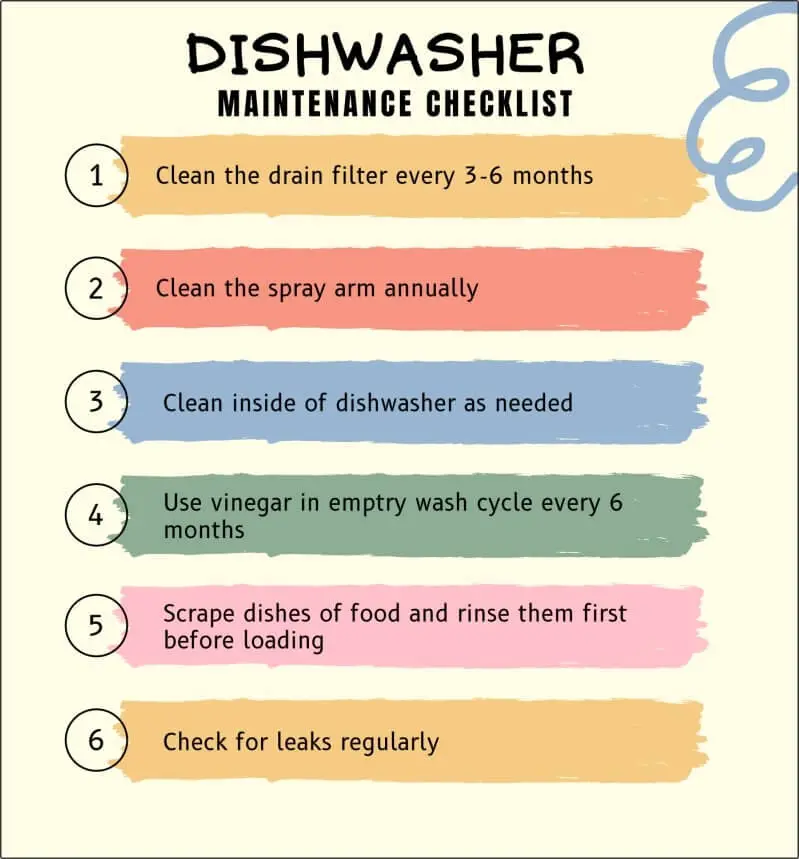The best guide for easy dishwasher cleaning
Your dishwasher is one of the most important appliances in your home. Not only does it make clean-up a breeze, but it also helps to keep your dishes clean and bacteria-free.
However, if you don’t clean it on a regular basis, it can become a cesspool of bacteria, fungus, and odors.
In this blog post, we will discuss how to properly clean your dishwasher and remove all of those nasty buildups that can shorten the life of your dishwasher and create an unpleasant environment.
The best way to clean a dishwasher with a bad odor is to start by removing and cleaning the filter, then use vinegar in an empty wash cycle.
How To Clean And Remove Bad Odors From Your Dishwasher With Easy Solutions:
Why Does My Dishwasher Have A Bad Odor?
There are several reasons that can cause the dishwasher to smell bad.
- Mold growth inside the dishwasher.
- Trapped food particles stuck in the filter, hose, spray arm, etc.
- Grime accumulated on inside parts of the dishwasher.
Mold can be caused by standing water that has not drained completely. Check for water that remains after a complete wash cycle and clear the filter if needed.
Food getting trapped and stuck in the drain filter is very common. Other places to check are the drain hose as well as the spray arm and around door seals.
Grime over time can accumulate on the inside walls, spray arm, and other inside parts. This grime can be a buildup from detergent, food, or other waste.
ALSO READ: [Most Common] Dishwasher Problems and How to Fix Them
Next, let’s talk about the best ways to clean odors from your dishwasher.
How To Clean A Dishwasher And Remove Odors
These 5 steps to clean your dishwasher are simple, and by following these easy steps, you can ensure that your dishwasher is clean, bacteria-free, and free of odors:
1) Clean The Drain Filter
Odors from the dishwasher very commonly come from food particles stuck in the drain filter. Some dishwashers have self-cleaning filters, while others have manual filters. Check your owner’s manual to locate your filter location.
Remove and clean the drain filter:
- Locate the dishwasher filter and pull it out. You may have to turn it counterclockwise to unlock it. It is commonly located on the bottom and you will probably need to remove the lower rack.
- Wash the filter with warm, soapy water with a gentle brush.
- Inspect the area inside the dishwasher around the filter for food debris and remove any.
- Reinstall the filter and put the rack back in place.
Note: Your dishwasher may have two filters. Check the manual for their locations.
Other Posts You May Like:
Easy Newbie Home Maintenance (Will Save Money)
Garbage Disposal Not Working | You Can Fix It
2) Clean The Spray Arm
The spray arms rotate and spray water to clean the dishes. If the holes in these spray arms become clogged, the dishwasher doesn’t work as well. In addition, the clogs can cause odors to form on the arms themselves.
Remove and clean spray arms:
- Remove the bottom rack from the dishwasher.
- Lift out and remove the middle and lower spray arms.
- Clean the spray arms in a sink with a gentle brush. Use toothpicks to remove particles stuck in the holes.
- Reinstall both spray arms and the bottom rack.

3) Clean The Inside Of The Dishwasher
Grime and soap scum can and often do accumulate on the inside walls of a dishwasher. Mold is also sometimes present on inside surfaces and door seals because of water.
Scrub the inside surfaces with hot soapy water and don’t forget the door seals. If you need to use a stronger cleaning solution, be sure to check your owner’s manual first. You can purchase dishwasher cleaner from most grocery stores or big box home centers.
To Clean The Door Gasket:
Using a sponge or cloth, clean the door gasket with hot, soapy water. If there is any mildew or mold present, use a vinegar and water solution to clean it. If needed, you can use a weak bleach solution on the gasket, but be sure to rinse with clear water afterward to remove any remaining bleach solution.
4) Run a Cleaning Cycle With Vinegar
After you have cleaned all the food debris from the inside of the dishwasher, run a cycle using vinegar.
The vinegar will clean the interior of your dishwasher, removing any build-up that has accumulated over time.
- Put a cup of white vinegar in a dishwasher-safe bowl.
- Place the bowl on the top rack of the dishwasher.
- Run the hottest cycle on the dishwasher. But do not run the drying cycle.
- Open the dishwasher door and let it dry completely.
If you have old, dried-on detergent caked on the inside, try brushing this area with vinegar for a few minutes to help loosen it up, then run a cleaning cycle.
Your dishwasher should now be odor free and performing as good as new.
Note: Do not mix vinegar and bleach. The combination produces a very dangerous and potentially fatal gas.
5) Prevention And Regular Maintenance
To keep your dishwasher clean and working properly, maintain a regular cleaning prevention routine.
- Scrape dishes of food and rinse them first before loading.
- Check and clean the drain filter(s) every 3-6 months.
- Clean the inside of the dishwasher about every 6 months if needed and run a cycle using vinegar as detailed above.
- To make sure the dishwasher gets hot water, run it through the faucet first.
How often you should clean your dishwasher
Clean your dishwasher after every 25 to 30 run cycles, or at least twice a year, to ensure that it is in excellent working condition. And, if you have hard water, clean it more frequently to prevent mineral build-up.
Did you know:
According to NSF.org: “a 2011 germ study conducted by NSF found that the germiest place in most homes wasn’t the bathroom, but the kitchen.“
One of the best ways to ensure you are effectively sanitizing your dishes is to buy a dishwasher rated and certified to NSF/ANSI 184: Residential Dishwashers. This is a standard that ensures residential dishwashers reach a 99.999% reduction of bacteria when operated on the sanitizing cycle.

Easy Dishwasher Cleaning – Summary
Follow the steps above for the best ways to clean your dishwasher. Food particles and gunk and mold can build up on many inside surfaces of the dishwasher. Be sure to check the filters and clean all surfaces to ensure proper functioning and remove bad odors.
Dreaming of a lush garden but only have a tiny balcony? Self-watering garden systems are your answer! Discover how these ingenious planters and DIY setups can help you create thriving green spaces, even indoors. Find top-rated products on Amazon and start growing today! Primary Query: How can I create a thriving garden in a small…
Continue Reading Self-Watering Gardens for Small Spaces: Grow Big in Tiny Places
People in the United States use a lot of water. Most of us take for granted a constant and steady supply of clean fresh water in our homes. As the weather becomes more unpredictable and the climate is producing extreme temperatures, the water tables are falling and general reservoir supplies are becoming more constrained. It’s…
Continue Reading How To Conserve Water At Home | How Can I Lower My Water Bill?
This article is a guide about selecting and buying the best outdoor pizza oven. Do you love pizza as much as we do? If so, you’ll know that there’s nothing quite like the taste of a fresh, homemade pizza. And what’s the best way to make a fresh pizza at home? With a pizza oven,…
Continue Reading Outdoor Pizza Oven Buying Guide | How to Buy



